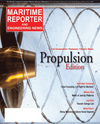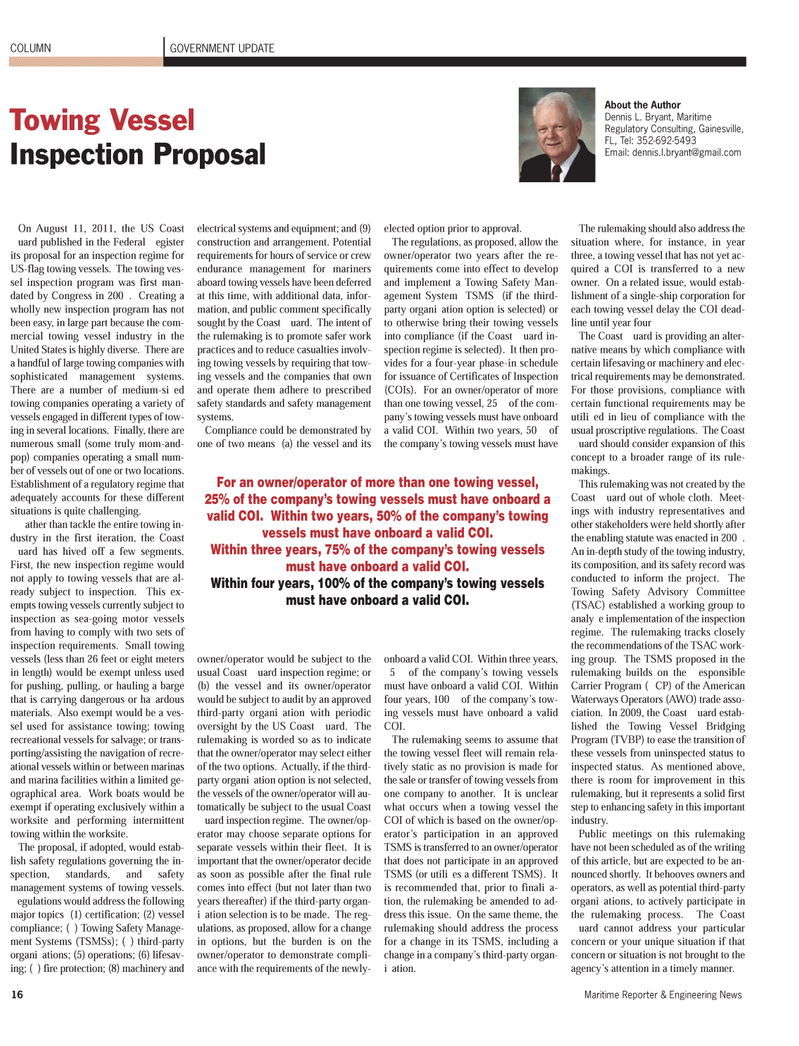
Page 16: of Maritime Reporter Magazine (September 2011)
Marine Propulsion Annual
Read this page in Pdf, Flash or Html5 edition of September 2011 Maritime Reporter Magazine
16Maritime Reporter & Engineering News GOVERNMENT UPDATE COLUMNTowing Vessel Inspection Proposal On August 11, 2011, the US Coast uard published in the Federal egister its proposal for an inspection regime for US-flag towing vessels. The towing ves- sel inspection program was first man- dated by Congress in 200. Creating a wholly new inspection program has not been easy, in large part because the com- mercial towing vessel industry in the United States is highly diverse. There are a handful of large towing companies with sophisticated management systems.There are a number of medium-sied towing companies operating a variety of vessels engaged in different types of tow- ing in several locations. Finally, there are numerous small (some truly mom-and-pop) companies operating a small num-ber of vessels out of one or two locations. Establishment of a regulatory regime that adequately accounts for these different situations is quite challenging.ather than tackle the entire towing in- dustry in the first iteration, the Coast uard has hived off a few segments. First, the new inspection regime would not apply to towing vessels that are al- ready subject to inspection. This ex- empts towing vessels currently subject to inspection as sea-going motor vessels from having to comply with two sets of inspection requirements. Small towing vessels (less than 26 feet or eight meters in length) would be exempt unless used for pushing, pulling, or hauling a barge that is carrying dangerous or haardous materials. Also exempt would be a ves- sel used for assistance towing; towing recreational vessels for salvage; or trans- porting/assisting the navigation of recre- ational vessels within or between marinas and marina facilities within a limited ge- ographical area. Work boats would be exempt if operating exclusively within a worksite and performing intermittent towing within the worksite. The proposal, if adopted, would estab- lish safety regulations governing the in- spection, standards, and safetymanagement systems of towing vessels. egulations would address the following major topics (1) certification; (2) vessel compliance; () Towing Safety Manage- ment Systems (TSMSs); () third-party organiations; (5) operations; (6) lifesav- ing; () fire protection; (8) machinery and electrical systems and equipment; and (9)construction and arrangement. Potentialrequirements for hours of service or crew endurance management for marinersaboard towing vessels have been deferred at this time, with additional data, infor- mation, and public comment specifically sought by the Coast uard. The intent of the rulemaking is to promote safer work practices and to reduce casualties involv- ing towing vessels by requiring that tow- ing vessels and the companies that own and operate them adhere to prescribedsafety standards and safety managementsystems.Compliance could be demonstrated byone of two means (a) the vessel and its owner/operator would be subject to the usual Coast uard inspection regime; or (b) the vessel and its owner/operator would be subject to audit by an approved third-party organiation with periodic oversight by the US Coast uard. The rulemaking is worded so as to indicate that the owner/operator may select either of the two options. Actually, if the third- party organiation option is not selected, the vessels of the owner/operator will au- tomatically be subject to the usual Coastuard inspection regime. The owner/op- erator may choose separate options forseparate vessels within their fleet. It is important that the owner/operator decide as soon as possible after the final rule comes into effect (but not later than two years thereafter) if the third-party organ- iation selection is to be made. The reg- ulations, as proposed, allow for a change in options, but the burden is on the owner/operator to demonstrate compli- ance with the requirements of the newly- elected option prior to approval. The regulations, as proposed, allow the owner/operator two years after the re- quirements come into effect to develop and implement a Towing Safety Man- agement System TSMS (if the third- party organiation option is selected) or to otherwise bring their towing vessels into compliance (if the Coast uard in- spection regime is selected). It then pro- vides for a four-year phase-in schedule for issuance of Certificates of Inspection (COIs). For an owner/operator of more than one towing vessel, 25 of the com- pany?s towing vessels must have onboard a valid COI. Within two years, 50 of the company?s towing vessels must have onboard a valid COI. Within three years, 5 of the company?s towing vessels must have onboard a valid COI. Within four years, 100 of the company?s tow- ing vessels must have onboard a valid COI.The rulemaking seems to assume thatthe towing vessel fleet will remain rela- tively static as no provision is made for the sale or transfer of towing vessels from one company to another. It is unclear what occurs when a towing vessel the COI of which is based on the owner/op- erator?s participation in an approved TSMS is transferred to an owner/operator that does not participate in an approved TSMS (or utilies a different TSMS). It is recommended that, prior to finalia- tion, the rulemaking be amended to ad-dress this issue. On the same theme, therulemaking should address the processfor a change in its TSMS, including a change in a company?s third-party organ- iation. The rulemaking should also address thesituation where, for instance, in yearthree, a towing vessel that has not yet ac- quired a COI is transferred to a new owner. On a related issue, would estab- lishment of a single-ship corporation foreach towing vessel delay the COI dead- line until year fourThe Coast uard is providing an alter- native means by which compliance with certain lifesaving or machinery and elec- trical requirements may be demonstrated.For those provisions, compliance with certain functional requirements may beutilied in lieu of compliance with the usual proscriptive regulations. The Coast uard should consider expansion of this concept to a broader range of its rule-makings.This rulemaking was not created by the Coast uard out of whole cloth. Meet- ings with industry representatives and other stakeholders were held shortly after the enabling statute was enacted in 200. An in-depth study of the towing industry, its composition, and its safety record was conducted to inform the project. The Towing Safety Advisory Committee (TSAC) established a working group to analye implementation of the inspection regime. The rulemaking tracks closely the recommendations of the TSAC work- ing group. The TSMS proposed in the rulemaking builds on the esponsible Carrier Program (CP) of the American Waterways Operators (AWO) trade asso- ciation. In 2009, the Coast uard estab- lished the Towing Vessel Bridging Program (TVBP) to ease the transition ofthese vessels from uninspected status to inspected status. As mentioned above, there is room for improvement in this rulemaking, but it represents a solid first step to enhancing safety in this importantindustry. Public meetings on this rulemakinghave not been scheduled as of the writing of this article, but are expected to be an- nounced shortly. It behooves owners and operators, as well as potential third-partyorganiations, to actively participate in the rulemaking process. The Coast uard cannot address your particularconcern or your unique situation if thatconcern or situation is not brought to theagency?s attention in a timely manner. For an owner/operator of more than one towing vessel, 25% of the companys towing vessels must have onboard a valid COI. Within two years, 50% of the companys towing vessels must have onboard a valid COI. Within three years, 75% of the companys towing vessels must have onboard a valid COI. Within four years, 100% of the companys towing vessels must have onboard a valid COI. About the AuthorDennis L. Bryant, Maritime Regulatory Consulting, Gainesville,FL, Tel: 352-692-5493 Email: [email protected]

 15
15

 17
17
